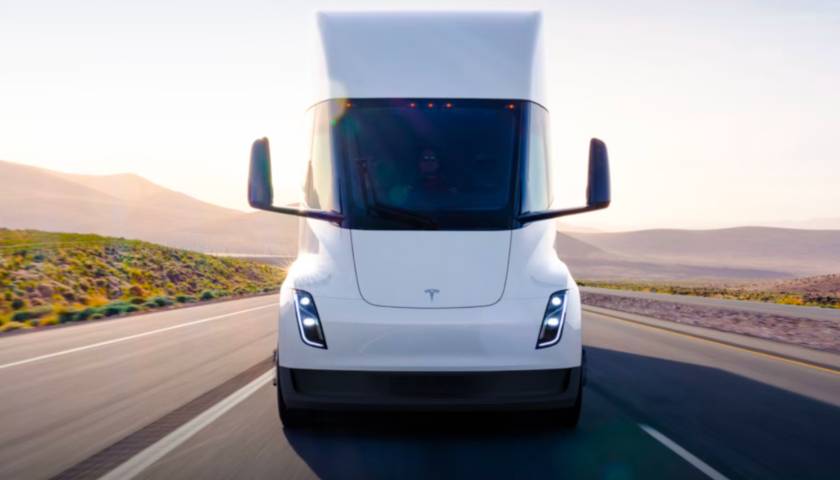by Kevin Killough
In 2022, California adopted regulations that required all new cars, trucks and SUVs sold in the state to be zero emissions by 2035. Immediately, 17 states eyed the electric vehicle mandates and started considering their own. That was on top of the Biden administration’s own tailpipe standards, which many say function as a federal EV mandate.
The vision of a forced electric vehicle transition hasn’t quite gone as California and the Biden administration have hoped. But in April 2023, California was still riding high on a wave of EV fever and set its ambitions on electrifying semi truck fleets.
The issues that have reduced consumer interest in EVs are compounded with heavy-duty semi trucks. A recent study by the American Transportation Research Institute (ATRI) finds that if California transitioned to an electrified trucking fleet, it would strain the state’s already stressed grid, take decades to source the minerals needed, and ultimately drive up the costs of goods for all Americans.
Starts in California
California’s 2022 Advanced Clean Fleets Regulation hoped to lay the groundwork for replacing diesel-powered semi trucks with electric ones, starting with drayage freight. Drayage trucks are those hauling goods to and from seaports to railyards. In 2022, there were over 140,000 drayage trucks operating in California, and approximately 33,500 of those trucks serviced the state’s seaports and railyards annually.
The regulation would have required them all to transition to zero-emissions vehicles starting this year, with 100% transitioned by 2035. As with California’s EV mandate, other states are looking at pushing their own electric semi truck regulations. In October, National Grid, which serves much of New York, launched a two-year study into the electrification of commercial fleets.
In October 2023, the California Trucking Association filed a federal lawsuit hoping to block the enforcement of California’s rules, arguing the rules conflict with federal law. California sought a waiver from the EPA, so that it may enforce the state’s own emissions standards. While the EPA mulls over the request, California isn’t enforcing the Advanced Clean Fleets Regulation.
Whether that reprieve results in the end of the electric semi truck mandates depends on what the EPA decides on the waiver, but the ATRI study raises questions about its feasibility.
“It’s certainly possible to run these heavy trucks on batteries, but the cost is incredible,” David Blackmon, an energy analyst who publishes “Energy Absurdities” on Substack, told Just The News.
Electricity, minerals and infrastructure
In looking at California’s semi truck transition, ATRI followed methodologies from a 2022 national analysis. The national analysis found that electrifying all vehicles on America’s roads would require 40% of all electricity generation. Some states would need more, including California, which would require 57.2% of its total electricity generation.
Tens of millions of tons of cobalt, graphite, lithium and nickel would also be needed, and that would take as much as 35 years at current global production rates and nearly 65% of global reserves of these minerals.
The analysis noted social impacts of this mining, which includes massive amounts of carbon dioxide that are produced in the energy-intensive mining and processing industries. The countries from where these materials are sourced lack the kind of labor protections of the developed world, meaning the exploitation of labor to mine the materials.
The weights of batteries would also take up a lot of the vehicle’s hauling capacity. Larger batteries would give trucks more range, but would mean a limited ability to carry freight. Ultimately, the analysis concluded, America’s highways would become even more congested since more trucks would be needed to haul the same amount of freight.
The charging infrastructure, as is a problem with passenger cars, would be an even larger challenge for electric semi trucks. Installation at the nation’s truck parking locations, according to ATRI, would be $35 billion. To supply the charging needs at a single rural rest stop would require enough daily electricity to power more than 5,000 U.S. households.
Another analysis by Guidehouse estimated that the electrification of America’s long-haul fleet would require 504 trillion watt hours annually. The average household uses about 899,000 watt hours per month. So, powering the nation’s long-haul trucks would require the same amount of electricity for more than 46 million homes every year.
“This is not something that’s affordable or sustainable to scale this up on a society-wide basis, or even a statewide basis within the state of California,” Blackmon said.
The ATRI California analysis points out that a new battery-electric truck cost $425,000, which is double the cost of a comparable diesel truck. At California’s electricity rates, which are nearly double the national average, the cost to power an electric semi truck, including equipment, installation and utility upgrades, could be as high as $1.21 per mile. That’s twice the cost per mile of diesel fuel, according to ATRI.
The Capital Press reports that operating margins for truckload carriers was about 10% of their revenue in 2021. The authors of the ATRI analysis told the Press that the added costs of electrification would erase those margins unless the costs were passed onto consumers.
Outright guess
California hopes that its electric truck mandates will lower particulate and carbon dioxide emissions. In the case of carbon dioxide emissions, it’s far from certain, according to a study by the Manhattan Institute.
Electric vehicles, the study explains, require far more upfront emissions to produce than their conventional counterparts. While the electric vehicles produce no emissions while being driven, the study finds that there are so many variables in the supply chains of producing electric vehicles that claims of emission reductions are based on “a rough estimate or an outright guess based on averages, approximations or aspirations.”
As the demand for minerals rises with demand, reductions, if there are any, will shrink and may even lead to a net increase, according to the study. That’s without considering any emissions from the electricity production to charge the vehicles.
Two researchers explain in the Wall Street Journal that California’s efforts to reduce particulate matter with EV mandates are also unlikely to result in reductions and may actually increase their concentrations. Since advancements in gas-powered car technology has greatly reduced particulate matter, the researchers say, very little particulates come from vehicles’ tailpipes. Most particulate emissions come from tire wear. Since EVs are heavier, they produce more particulate matter.
Writing in The Telegraph, Blackmon said that the cost of this forced electric vehicle transition has to be considered in the context of a nation that’s $34 trillion in debt.
“How much more of a load will we force our future generations to bear before someone in a position of authority has the good sense to demand an accounting and reconsideration of this headlong rush into a green debtor’s prison?” Blackmon wrote.
– – –
Kevin Killough is a reporter at Just The News.
Photo “Tesla Semi Truck” by Tesla.





